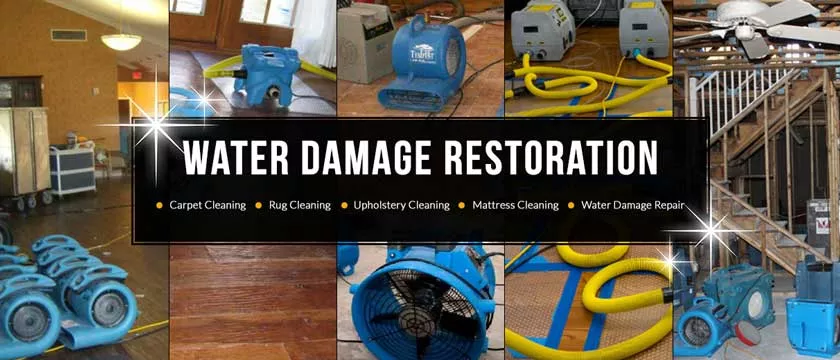Water damage is a distressing and usually unforeseen event that can occur in any residence, resulting from diverse sources such as flooding, burst pipes, or roof leaks.

Water Damage Restoration Tips Everyone Should Know
Being prepared and comprehending how to respond effectively can make a significant difference in mitigating the damage and restoring your property.
We’ll investigate essential water damage restoration tips that everyone should be aware of to navigate through this challenging situation.
1. Prioritize Safety First:
Your immediate concern should be the safety of yourself and your family. Ensure that you are safe from electrical hazards by turning off the electricity supply to the impacted area.
If there’s a hazard of structural damage, sidestep entering the affected area until it has been declared safe by professionals.
Additionally, be cautious about slipping on wet surfaces and watch out for any loose or sharp objects that may pose a danger. Safety should always be the top priority in water damage restoration.
2. Stop the Source of Water:
Identifying and stopping the source of water is a crucial step to prevent further damage. If the water damage is due to a plumbing issue like a burst pipe or a leaking faucet, turn off the water supply to your home or the specific area with the problem.
For roof leaks, try to cover the damaged area with tarps or plastic sheeting to minimize further water infiltration. Halting the source of water is vital to stem ongoing damage and reduce the overall scope of the problem.
3. Document the Damage:
After ensuring safety and addressing the source of water, start documenting the damage thoroughly. Take photographs and videos of the affected areas, capturing the extent of the damage and any valuable items that have been impacted. This documentation will be crucial for insurance claims and assessing the severity of the damage.
Create a detailed inventory of damaged items, including their approximate value and any relevant purchase receipts or appraisals. Keeping thorough records is essential when dealing with insurance adjusters.
4. Contact Your Insurance Company:
Once you have documented the damage, get in touch with your insurance company as soon as possible to report the incident. Be prepared to provide details about the cause of the damage, the extent of the affected areas, and any relevant documentation you’ve gathered.
Your insurance company will usher you through the claims process and provide instructions on how to proceed.
Timely communication with your insurance company is crucial, as many policies have specific timeframes for reporting incidents and filing claims.
5. Remove Excess Water:
After addressing safety concerns, stopping the source of water, and documenting the damage, your next step is to begin removing excess water. Depending on the severity of the water damage, you may need to use buckets, towels, mops, or wet-dry vacuums to extract standing water.
The objective is to stem further saturation of building materials like drywall, flooring, and insulation, which can lead to structural damage and mold growth. Promptly removing excess water is essential to minimize these risks.
6. Promote Air Circulation:
Improving air circulation in the affected areas is paramount to facilitate drying and reduce humidity levels. Open windows and doors if possible to increase ventilation. Utilize fans and dehumidifiers to aid in the drying process.
Ensuring proper ventilation helps stem mold growth and reduces the time it takes for the affected areas to dry out. Mold can initiate to develop within 24 to 48 hours after water damage, so ventilation is crucial in the early stages.
7. Salvage Valuable Items:
If you have valuable items that are at danger of additional damage, bear steps to salvage them. Remove wet items from the affected area and place them in a dry, safe location. Depending on the item, you may need to perform specialized drying techniques or consult with restoration professionals.
Items such as documents, photographs, and electronics should be prioritized for salvage efforts, as they can deteriorate rapidly when exposed to water.
8. Elevate Furniture and Belongings:
Raise furniture and belongings off the wet floor to stem further damage. Use blocks, foam, or other materials to elevate items above the water level. This step is especially important for wooden furniture, which can absorb moisture and become warped or damaged. Additionally, remove rugs and other floor coverings to allow the underlying flooring to dry more efficiently.
Water damage restoration can be a challenging and emotionally draining process, but being prepared and knowing the right steps to take is essential for a successful outcome.
Prioritizing safety, acting promptly, and seeking professional help are paramount steps in mitigating further damage and preserving the integrity of your property.
Documenting the damage, collaborating with your insurance company, and implementing preventive measures for the future are also important aspects of the recovery process.
By following these water damage restoration tips, you can navigate through this challenging situation more effectively and ensure that your property is restored to its pre-damage condition.
When facing the aftermath of fire damage, you can trust our fire restoration services in Seattle, WA to restore your property to its pre-fire condition with care and expertise.
